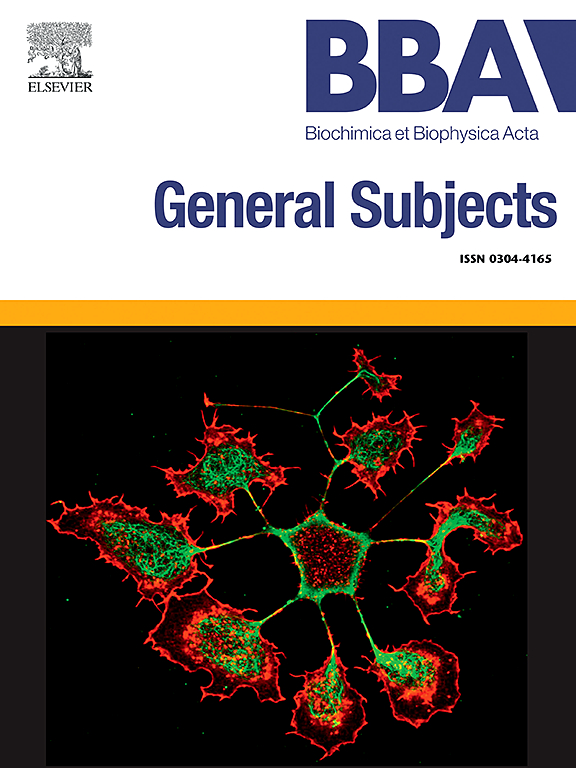探讨自组装与淀粉样蛋白多肽抗菌活性之间的关系:胰岛淀粉样蛋白多肽为例研究
IF 2.2
3区 生物学
Q3 BIOCHEMISTRY & MOLECULAR BIOLOGY
Biochimica et biophysica acta. General subjects
Pub Date : 2025-04-21
DOI:10.1016/j.bbagen.2025.130812
引用次数: 0
摘要
抗菌肽(AMPs)是多种生物先天免疫系统的关键成分。有趣的是,一些amp可以采用β-片二级结构并自组装成淀粉样原纤维。最近的研究也表明,淀粉样蛋白肽具有抗菌特性,并与amp具有共同的质膜扰动机制。本研究以胰岛淀粉样多肽(IAPP)为模型,探讨了淀粉样多肽的抑菌活性与其自组装之间的关系。IAPP是一种易于聚集的37-残基激素,其胰腺沉积和积累与II型糖尿病有关。抗菌试验表明,IAPP单体和纤维前聚集体,包括可溶性低聚物,抑制大肠杆菌和表皮葡萄球菌的生长。此外,单体和原纤维蛋白干扰阴离子脂质囊泡,使其模仿细菌质膜并降低代谢活性。相比之下,预组装的淀粉样蛋白原纤维表现出较弱的抗菌活性和脂膜扰动,尽管它们热切地凝集细菌。通过利用残基特异性取代来调节聚集倾向,我们观察到淀粉样蛋白形成受阻的衍生物保留了抗菌活性,而那些淀粉样蛋白自组装加速的衍生物抗菌效果较弱。此外,通过调节IAPP折叠成α-螺旋的倾向,我们观察到淀粉样蛋白的形成不是抗菌活性的先决条件,而螺旋折叠的不稳定降低了IAPP的抗菌活性。这项研究提供了IAPP适度抗菌活性的基本机制见解,并强调在推广自组装淀粉样多肽的抗菌潜力之前应采取预防措施。本文章由计算机程序翻译,如有差异,请以英文原文为准。
Probing the relationships between self-assembly and the antimicrobial activity of amyloidogenic peptides: The islet amyloid polypeptide as a case study
Antimicrobial peptides (AMPs) are key components of the innate immune system across diverse organisms. Interestingly, some AMPs can adopt β-sheet secondary structure and self-assemble into amyloid-like fibrils. Recent works have also revealed that amyloidogenic peptides exhibit antimicrobial properties and share a common mechanism of plasma membrane perturbation with AMPs. In this study, we explored the relationships between the antimicrobial activity of amyloidogenic peptides and their self-assembly by using the islet amyloid polypeptide (IAPP) as a model. IAPP is an aggregation-prone 37-residue hormone whose pancreatic deposition and accumulation are associated with type II diabetes. Antimicrobial assays revealed that IAPP monomers and prefibrillar aggregates, including soluble oligomers, inhibit the growth of Escherichia coli and Staphylococcus epidermidis. Additionally, monomeric and prefibrillar proteospecies perturbed anionic lipid vesicles that mimic bacterial plasma membrane and decrease the metabolic activity. In contrast, pre-assembled amyloid fibrils exhibited weak antimicrobial activities and lipid membrane perturbation, although they agglutinated bacteria avidly. By taking advantage of residue-specific substitutions that modulate the aggregation propensity, we observed that derivatives with hindered amyloidogenicity retained antimicrobial activities, while those with accelerated kinetics of amyloid self-assembly had weaker antimicrobial effect. Moreover, by modulating the propensity of IAPP to fold into an α-helix, we observed that amyloid formation is not a prerequisite for the antimicrobial activity, while the destabilization of helical folding reduced IAPP antimicrobial activity. This study provides fundamental mechanistic insights of the modest antimicrobial activity of IAPP and highlights that precaution should be taken before generalizing the antimicrobial potential of self-assembling amyloid polypeptides.
求助全文
通过发布文献求助,成功后即可免费获取论文全文。
去求助
来源期刊

Biochimica et biophysica acta. General subjects
生物-生化与分子生物学
CiteScore
6.40
自引率
0.00%
发文量
139
审稿时长
30 days
期刊介绍:
BBA General Subjects accepts for submission either original, hypothesis-driven studies or reviews covering subjects in biochemistry and biophysics that are considered to have general interest for a wide audience. Manuscripts with interdisciplinary approaches are especially encouraged.
 求助内容:
求助内容: 应助结果提醒方式:
应助结果提醒方式:


